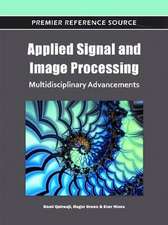Study and Design of Differential Microphone Arrays: Springer Topics in Signal Processing, cartea 6
Autor Jacob Benesty, Jingdong Chenen Limba Engleză Hardback – 23 oct 2012
for the design, implementation, and performance analysis of DMAs. The theory includes some signal processing techniques for the design of commonly used first-order, second-order, third-order, and also the general Nth-order DMAs. For each order, particular examples are given on how to form standard directional patterns such as the dipole, cardioid, supercardioid, hypercardioid, subcardioid, and quadrupole. The study demonstrates the performance of the different order DMAs in terms of beampattern, directivity factor, white noise gain, and gain for point sources. The inherent relationship between differential processing and adaptive beamforming is discussed, which provides a better understanding of DMAs and why they can achieve high directional gain. Finally, we show how to design DMAs that can be robust against white noise amplification.
| Toate formatele și edițiile | Preț | Express |
|---|---|---|
| Paperback (1) | 885.18 lei 6-8 săpt. | |
| Springer Berlin, Heidelberg – 9 noi 2014 | 885.18 lei 6-8 săpt. | |
| Hardback (1) | 889.75 lei 6-8 săpt. | |
| Springer Berlin, Heidelberg – 23 oct 2012 | 889.75 lei 6-8 săpt. |
Din seria Springer Topics in Signal Processing
- 18%
 Preț: 953.65 lei
Preț: 953.65 lei -
 Preț: 455.63 lei
Preț: 455.63 lei - 18%
 Preț: 1113.09 lei
Preț: 1113.09 lei - 15%
 Preț: 640.88 lei
Preț: 640.88 lei - 15%
 Preț: 643.48 lei
Preț: 643.48 lei - 15%
 Preț: 640.71 lei
Preț: 640.71 lei - 15%
 Preț: 704.04 lei
Preț: 704.04 lei - 15%
 Preț: 632.33 lei
Preț: 632.33 lei - 18%
 Preț: 781.45 lei
Preț: 781.45 lei - 18%
 Preț: 940.39 lei
Preț: 940.39 lei - 18%
 Preț: 728.28 lei
Preț: 728.28 lei -
 Preț: 424.61 lei
Preț: 424.61 lei - 15%
 Preț: 647.59 lei
Preț: 647.59 lei - 15%
 Preț: 605.39 lei
Preț: 605.39 lei - 18%
 Preț: 893.40 lei
Preț: 893.40 lei - 18%
 Preț: 947.35 lei
Preț: 947.35 lei - 15%
 Preț: 636.80 lei
Preț: 636.80 lei - 18%
 Preț: 776.88 lei
Preț: 776.88 lei - 15%
 Preț: 641.03 lei
Preț: 641.03 lei - 18%
 Preț: 782.72 lei
Preț: 782.72 lei
Preț: 889.75 lei
Preț vechi: 1085.06 lei
-18% Nou
Puncte Express: 1335
Preț estimativ în valută:
170.30€ • 177.12$ • 142.71£
170.30€ • 177.12$ • 142.71£
Carte tipărită la comandă
Livrare economică 13-27 martie
Preluare comenzi: 021 569.72.76
Specificații
ISBN-13: 9783642337529
ISBN-10: 364233752X
Pagini: 192
Ilustrații: VIII, 184 p.
Dimensiuni: 155 x 235 x 16 mm
Greutate: 0.41 kg
Ediția:2013
Editura: Springer Berlin, Heidelberg
Colecția Springer
Seria Springer Topics in Signal Processing
Locul publicării:Berlin, Heidelberg, Germany
ISBN-10: 364233752X
Pagini: 192
Ilustrații: VIII, 184 p.
Dimensiuni: 155 x 235 x 16 mm
Greutate: 0.41 kg
Ediția:2013
Editura: Springer Berlin, Heidelberg
Colecția Springer
Seria Springer Topics in Signal Processing
Locul publicării:Berlin, Heidelberg, Germany
Public țintă
ResearchCuprins
Introduction.- Problem Formulation.- Study and Design of First-Order Differential Arrays.- Study and Design of Second-Order Differential Arrays.- Study and Design of Third-Order Differential Arrays with Three Distinct Nulls.- Minimum-Norm Solution for Robust Differential Arrays.- Study and Design of Differential Arrays with the MacLaurin’s Series Approximation.
Textul de pe ultima copertă
Microphone arrays have attracted a lot of interest over the last few decades since they have the potential to solve many important problems such as noise reduction/speech enhancement, source separation, dereverberation, spatial sound recording, and source localization/tracking, to name a few. However, the design and implementation of microphone arrays with beamforming algorithms is not a trivial task when it comes to processing broadband signals such as speech. Indeed, in most sensor arrangements, the beamformer tends to have a frequency-dependent response. One exception, perhaps, is the family of differential microphone arrays (DMAs) that have the promise to form frequency-independent responses. Moreover, they have the potential to attain high directional gains with small and compact apertures. As a result, this type of microphone arrays has drawn much research and development attention recently. This book is intended to provide a systematic study of DMAs from a signal processing perspective. The primary objective is to develop a rigorous but yet simple theory for the design, implementation, and performance analysis of DMAs.
Caracteristici
Provides a systematic study of differential microphone arrays from a signal processing perspective Develops fundamental theory and algorithms Explores to analyze and explain DMAs’ performance and limitations Includes supplementary material: sn.pub/extras






























